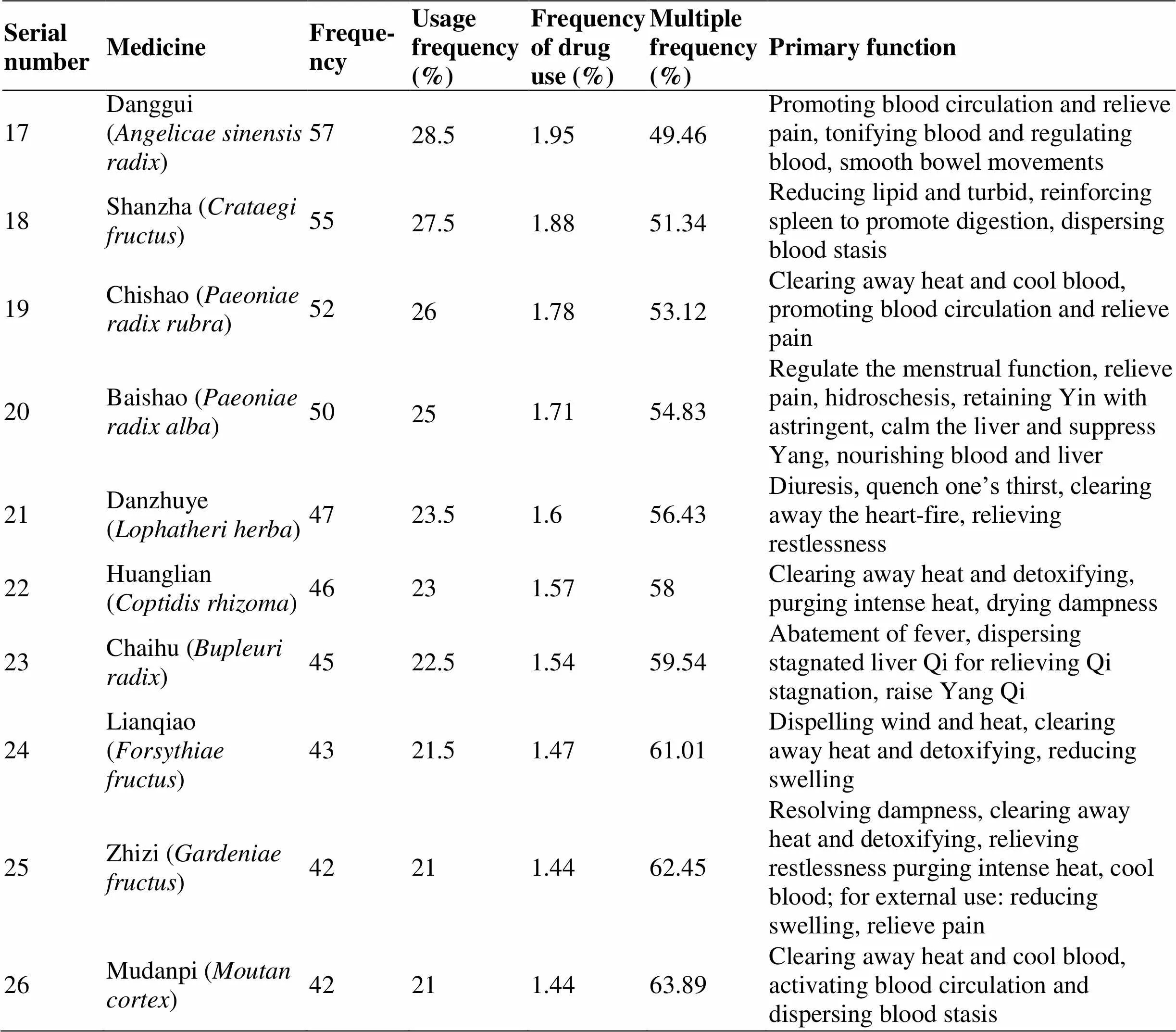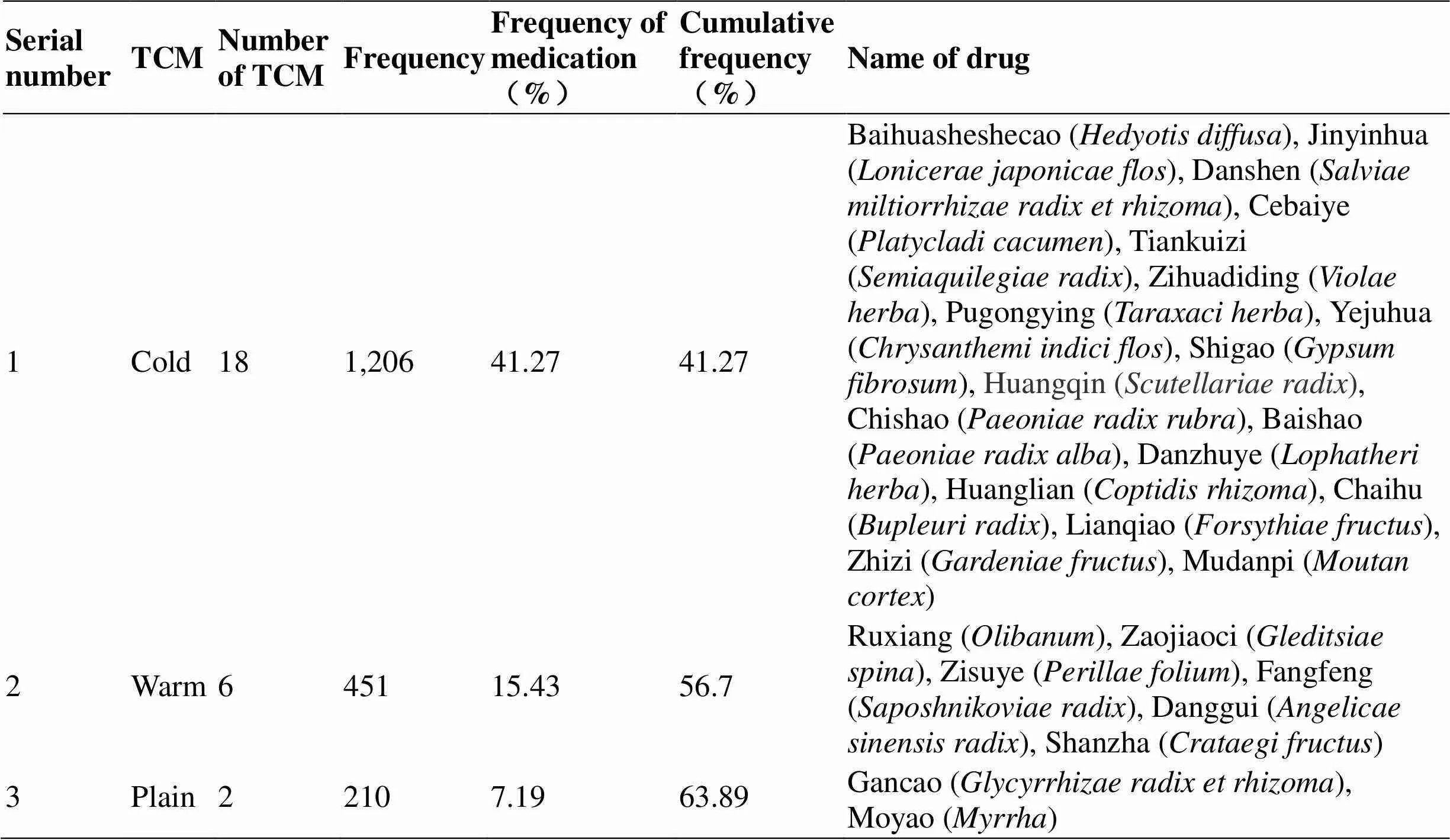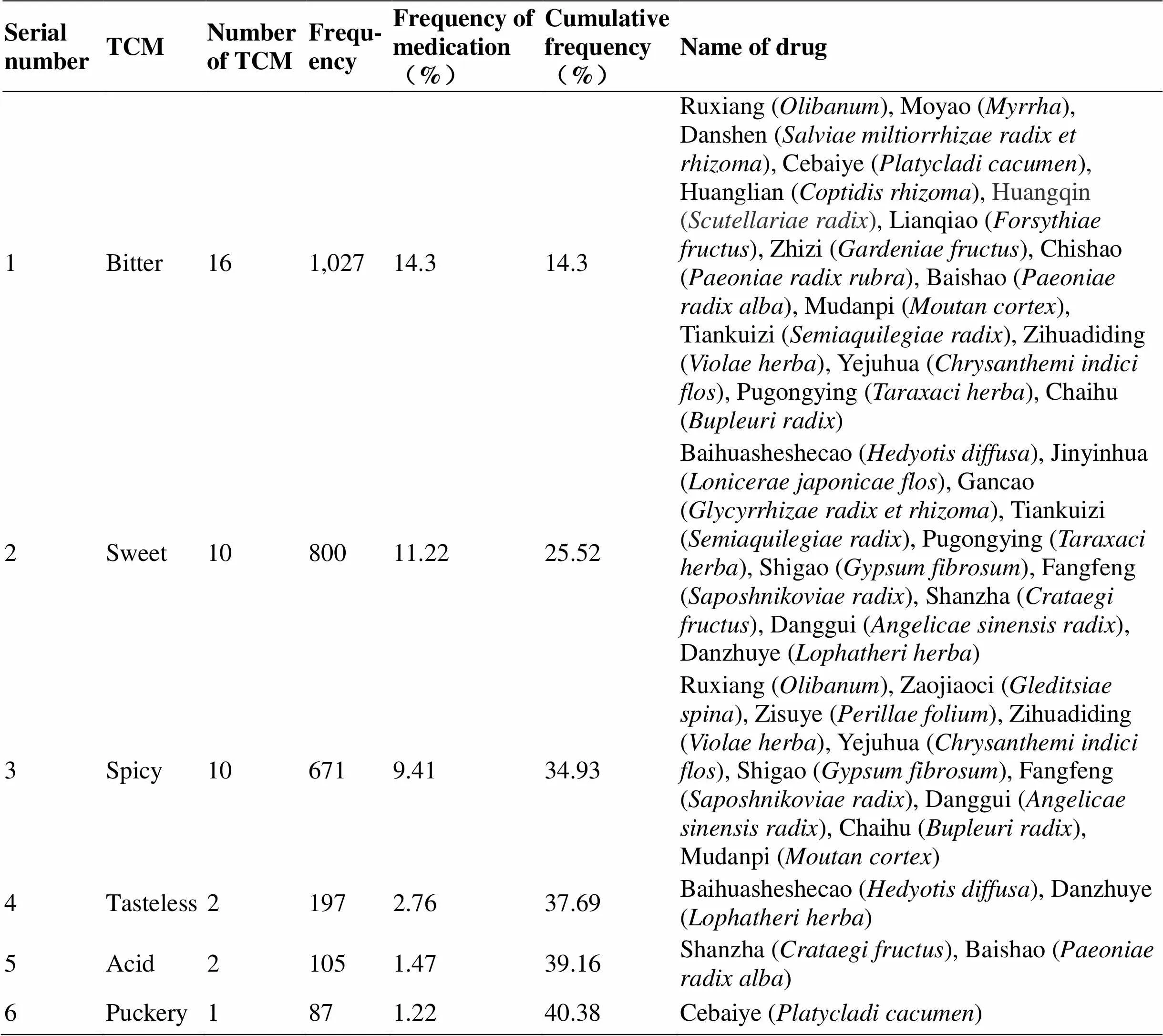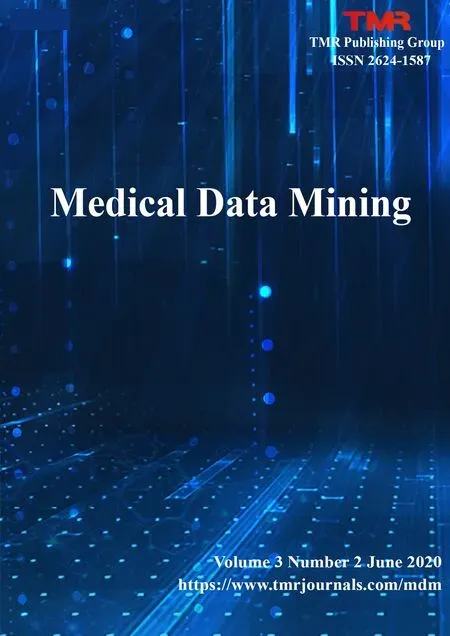Characteristic of prescriptions from associate professor Lifen Wang for acne vulgaris: a data mining analysis
Hai-Die Liu, Ming-Kai Wang, Yu-Rong Zhao, Hai-Ping Duan, Li-Fen Wang
Characteristic of prescriptions from associate professor Lifen Wang for acne vulgaris: a data mining analysis
Hai-Die Liu1, Ming-Kai Wang1, Yu-Rong Zhao1, Hai-Ping Duan1, Li-Fen Wang2*
1Yunnan University of Traditional Chinese Medicine, Kunming, 650500 China;2First Affiliated Hospital of Yunnan University of Traditional Chinese Medicine/Yunnan Provincial Hospital of Traditional Chinese Medicine, Kunming 650021, China.
This study aimed to summarize the characteristic of prescriptions from associate professor Lifen Wang for acne vulgaris by data mining analysis.Medical records of outpatients for treating acne vulgaris from associate professor Lifen Wang were collected indermatology department in Yunnan Provincial Hospital of Traditional Chinese Medicine. SPSS 20.0 software was used to calculate the frequency of drugs. Weka 3.8 software was used to analyze the correlation of drugs. Cytoscape 3.6.1 softwwere was used to present the results of association rule analysis in the form of network figure. A new formula for treating acne vulgaris was obtained by hierarchical clustering algorithm.The high-frequency drugs for the treatment of this disease were Baihuasheshecao (),Jinyinhua (),Gancao (),Ruxiang (),et alThe efficacy of high-frequency drugs includes heat-clearing, blood-activating and blood-removing, and deficiency-tonifying, accounting for 63.93% of the total frequency. The primary property of high-frequency drugs is coldfollowed by warm and flat, accounting for 63.89% of the total frequency. The taste of high-frequency drugs includes bitter, sweet and spicy, et al., accounting for 40.38% of the total frequency. The meridialof high-frequency drugs includes liver, heart, spleen, stomach, and lung, et al., account for 43.23% of the total frequency. The most commonly used combination of drugs was Ruxiang () plusMoyao ()from the association rules of high-frequency drugs.Associate professor Lifen Wang commonly uses Baihuasheshecao (),Jinyinhua (), Gancao (),Ruxiang () in the treatment of acne vulgaris. The primary properties of used drugs were cold, warm, and plain. The primary drug pairs were Ruxiang () plusMoyao (), Cebaiye ()plus Baihuasheshecao (), et al. Main functions of new prescriptions for the treatment of acne vulgaris include reducing swelling and removing stasis, clearing the heat and removing toxins, promoting blood circulation and removing blood stasis.
Acne vulgaris, Characteristic, Prescriptions,Data mining
This study summarized the characteristic of prescriptions from associate professor Lifen Wang for acne vulgaris by data mining analysis. Baihuasheshecao (), Jinyinhua (), Gancao (), and Ruxiang () are commonly used for treating acne vulgaris by associate professor Lifen Wang. The primary properties of used drugs were cold, warm, and plain. The primary drug pairs were Ruxiang () plus Moyao (), Cebaiye () plus Baihuasheshecao (), et al. Main functions of new prescriptions for the treatment of acne vulgaris include reducing swelling and removing stasis, clearing the heat and removing toxins, promoting blood circulation and removing blood stasis.

Background
Acne vulgaris refers to the inflammatory response in the skin sebaceous glands and hair follicles.It is commonon the face, chest and back, and characterizedby mound herpes, acne or nodules [1]. This disease is caused by mulriple factors, such as hormone unbalance, abnormal ductal keratosis of sebaceous glands in hair follicles, microbial infection,et al. The prevalence rate of acne vulgaris among adolescents is about 80%, and life and work in 88% of the patientswere affected by acne vulgaris [2]. Western medicinesfor this disease aremainly anti-inflammatory drugs [3], but the clinical effect is sub-optimal. Traditional Chinese medicine (TCM) is convenient and inexpensive.Oral TCMusually has good clinical effect, and less side effects [4]. TCM is characterizedby holistic viewand treatment based on syndrome differentiation.It is important to analyze the law of prescriptions of experienced Chinese medicine doctors for treating acne vulgaris.
This study aimed to summarize the characteristic of prescriptions from associate professor Lifen Wang for acne vulgaris by data mining analysis.
Materials and methods
Data sources
Medical records of outpatients for treating acne vulgaris from associate professor Lifen Wang were collected inDermatology Department in Yunnan Provincial Hospital of Traditional Chinese Medicine. The patients were treated from September to December 2019.
Inclusion criteria
(1) Patients should be diagnosed with acne vulgaris based on specific diagnostic criteria. (2) Studies should include standardized inclusioncriteria, exclusion criteria, and efficacy indicators. (3) Interventions should be TCM decoction and specific name of drugsshould be listed.
Data management
The names of the same Chinese herbs may be different due to different regions, variety and processing methods, et al. In this study, the name, sexual taste and meridian were standardized according to the[5]. Qualified data were inputted into Excel 2010 software.
Statistical methods
SPSS 20.0 software was used to calculate the frequency of drugs. Weka 3.8 software was used to analyze the correlation of drugs. Cytoscape 3.6.1 softwwere was used to present the results of association rule analysis in the form of network figure. A new formula for treating acne vulgaris was obtained by hierarchical clustering algorithm.
Results
Screening records
According to the inclusion and exclusion criteria, 200 Chinese medical records on acne vulgaris were finally included. The medical records included 200 prescriptions of Chinese medicine decoction including 133Chinese medicine.
Distribution of high-frequency drugs
Table 1 shows that the high-frequency drugs include Baihuasheshecao (), Jinyinhua (),Gancao (), Ruxiang (), et al. The cumulative frequency was 1,867 times, accounting for 63.89% of the total frequency (2,922 times).
Efficacy distribution of high-frequency drugs
Table 2 shows that the efficacy of high-frequency drugs includes 7 categories, such as tonifying deficiency, clearingheat, and invigorating blood circulation and eliminating stasis. The cumulative frequency was 1,867 times, accounting for 63.93% of the total frequency (2,922 times).
Properties distribution of high-frequency drugs
Table 3 shows that the properties of high-frequency drugs include 3 types: cold, warm and flat. The cumulative frequency was 1,867 times, accounting for 63.89% of the total frequency (2,922 times).
Flavor distribution of high frequency drugs
Table 4 shows that there are 6 kinds flavors of high-frequency drugs, such as sweet and bitter. The cumulative frequency was 2,887 times, accounting for 40.38% of the total frequency (7,133 times).
Meridial distribution of high-frequency drugs
Table 5 shows that meridial of high-frequency drugs includes 11 types, such as liver, heart, spleen, stomach and lung. The cumulative frequency was 5,044 times, accounting for 43.23% of the total frequency (11,667 times).
Association rules on high-frequency drugs
In the association rule analysis, minimum support was set as 27.5%, minimum confidence 96% and maximum previous item number 1 (Table 6, Figure 1). The more lines connected to a drug, the more frequency of usageof this drug.
New prescriptions for acne vulgaris based on hierarchical clustering
According to the number of selected prescriptions for acne vulgaris and different parameters, an unsupervised hierarchical clustering algorithm was applied to carry out entropy hierarchical clustering analysis.A total of 5 new prescriptions for acne vulgaris were obtained (Table 7).

Table 1 Distribution of high-frequency drugs

Table 1 Distribution of high-frequency drugs (continued)

Table 2 Efficacy distribution of high-frequency drugs

Table 2 Efficacy distribution of high-frequency drugs (continued)
TCM, traditional Chinese medicine.

Table 3 Properties distribution of high-frequency drugs
TCM, traditional Chinese medicine.
Discussion
Acne vulgaris, as a common clinical skin disorder, has the characteristics of recurrence and damaged skin, seriously affects the quality of life and mental health of the patients [6]. Acne is called “lungfeng acne” in Chinese medicine, and caused by blood-heat in lung channel, often occurs in the face and nose [7]. On the basis of the treatment experience of the ancients, modern doctors have put forward many valuable views on TCM for acne. Guowei Xuan [8] thinks that the cause of the imbalance of Yin and Yang is the kidney Yin deficiency, which affects the physiological function of the skin, leads to change physiology of skin, and causes pathological changes. Therefore, the treatment of acne should be drugs for enriching Yin and nourishing kidney. Fuxing Liu [9] indicates that this disease should be treated using drugs for dispelling dampness and resolving toxin. Lifen Wang believes that the pathogenic factors of acne were mainly liver stagnation, spleen deficiency and dampness, lung stagnation and blood stasis. According to the treatment program of modern masters, it can be seen that the treatment of acne vulgaris is mainly focused on clearing heat and detoxification, promoting blood circulation and removing blood stasis, and soothing liver and relieving depression. TCM can not only reduce swelling and tangle, but also have a good anti-inflammatory effect. Therefore, it is necessary to summarize the characteristic of prescriptions for acne vulgaris.
Distribution analysis of high-frequency drugs
The top 3 high-frequency drugs wereBaihuasheshecao () (150 times),Jinyinhua ()(131 times),Gancao ()(106 times). Modern pharmacology studies show that Baihuasheshecao () can slow aging, treat tumor, et al [10]. Baihuasheshecao () may be useful to improve blood circulation, has anti-inflammatory sterilization for patients with acne. Modern pharmacology research shows that Jinyinhua () has the effects of resisting inflammation, killing bacteria, et al. It can be used in the antibacterial treatment of acne vulgaris [11]. Modern pharmacology research shows that Gancao ()has effectsfor regulating immune system, anti-oxidation, anti-inflammation, et al. [12].

Table 4 Flavor distribution of high frequency drugs
TCM, traditional Chinese medicine.

Table 5 Meridial distribution of high-frequency drugs

Table 5 Meridial distribution of high-frequency drugs (continued)
TCM, traditional Chinese medicine.

Table 6 Association rules on high-frequency drugs

Figure 1 Network figure of association rules on high-frequency drugs

Table 7 New prescriptions for acne vulgaris based on hierarchical clustering
Analysis of efficacy distribution of high-frequency drugs
The top 3 types of high-frequency drugs based on efficacy distribution were heat-clearing drugs (936 times), blood-activating and blood-stasis removing drugs (297 times), and nourishing deficiency drugs (213 times). It suggests that associate professor Lifen Wang treats acne vulgaris mainly with heat-clearing, blood-activating and blood-stasis removing drugs.
Analysis of flavor distribution of high frequency drugs
The top 3 types of flavorof high frequency drugswere bitterness (1,027 times), sweet (800 times) and spicy (671 times). Bitter taste can clear heat, clear damp, et al. Sweet taste can supplement healthy atmosphere, protect the spleen and stomach, et al. Spicy taste can promote the flow of Qi and blood, et al. Bitter, sweet and spicy are accordant with the etiology and pathogenesis of acne fever.
Meridial distribution of high-frequency drugs
The top 4 types of meridial of high-frequency drugs were liver (1,294 times), heart (898 times), spleen (830 times) and stomach (745 times). The liver can regulate the viscera qi activity. Treatments for acne vulgaris should be focused on liver soothing, clearing damp, and blood stasis clearing. For the treatment of acne vulgaris, the method of activating blood circulation and removing blood stasis has been usually used. In this study, medication rules for this disease were reflected intuitively.
Association rule analysis of high-frequency drugs
Drugs with the highest support degree were Ruxiang () plusMoyao (), Cebaiye ()plus Baihuasheshecao (),Tiankuizi () plusBaihuasheshecao (), Zihuadiding () plus Baihuasheshecao (), Zihuadiding ()plus Tiankuizi (), et al. These drugs have the function of detoxification, heat dissipation, blood circulation, and blood stasis removal.
New prescriptions based on hierarchical clustering
Five new prescriptions for the treatment of acne vulgaris were obtained by data mining from 200 prescriptions. Prescription 1 can clear the heat and remove toxins, reduce swelling and remove stasis. Prescription 2 can reduce swelling and remove stasis, promote blood circulation and remove blood stasis. Prescription 3 can remove stasis and cool blood, clear the heat and remove toxins. Prescription 4 can promote blood circulation and remove blood stasis, relieve exterior syndrome and dispel wind. Prescription 5 can promote blood circulation and clear heat, help digestion.
Conclusion
Associate professor Lifen Wang commonly uses Baihuasheshecao (),Jinyinhua (), Gancao (),Ruxiang () in the treatment of acne vulgaris. The primary properties of used drugs were cold, warm, and plain. The primary drug pairs were Ruxiang () plusMoyao (), Cebaiye ()plus Baihuasheshecao (), et al. Main functions of new prescriptions for the treatment of acne vulgaris include reducing swelling and removing stasis, clearing the heat and removing toxins, promoting blood circulation and removing blood stasis.
1. Li GZ. Epidemiological investigation of acne and classification of traditional Chinese medicine. Beijing University of Traditional Chinese Medicine, 2007.
2. Ma MS. High-throughput analysis of epidemiology and dermatitis flora in patients with acne vulgaris. Zunyi Medical University, 2019.
3. Gu SY, Zhang X, Zhou JR. Research progress in the treatment of acne vulgaris. Chin J Aesth Med 2019, 28: 170–173.
4. Fu X, Wan J, Huang S. Research progress of traditional Chinese medicine in the treatment of acne. World Latest Med Inform 2019, 19: 23–24.
5. Zhong GS.. Beijing: China Press of Traditional Chinese Medicine, 2012.
6. Ma YM, Yang ZY, Yang Y, et al. Research status of Chinese and western medicine in the treatment of acne vulgaris. Chin J Clin Ration Drug Use 2019, 12: 197 + 5.
7. Yang XZ. Research on etiology and pathogenesis of acne in traditional Chinese and western medicine. J Tianjin Univ Tradit Chin Med 2019, 38: 329–335.
8. Guan HX. Xuan Guowei famous doctor of traditional Chinese medicine acne diagnosis and treatment experience of mining research. Guangzhou University of Chinese Medicine, 2012.
9. Lu GL, Liu FX. Introduction to the experience of chief physician in the treatment of acne. Hunan J Tradit Chin Med 1999, 2: 16–17.
10. Jiang YN. Progress in the study of the active ingredients and pharmacological effects of. Natl Med J China 2019, 3: 235–235.
11. Zhang JY. Analysis of the medicinal components and pharmacological effects of honeysuckle. Guide China Med 2019, 17: 177–178.
12. Li J, Li X, Cao MM, et al. Progress in the research of pharmacology action and drug pair compatibility ratio of licorice. Shanghai J Tradit Chin Med 2019, 53: 83–87.
10.12032/MDM2020063003
:
TCM, traditional Chinese medicine.
:
The authors declare that they have no conflict of interest.
:
Hai-Die Liu, Ming-Kai Wang, Yu-Rong Zhao, et al. Characteristic of prescriptions from associate professor Lifen Wang for acne vulgaris: a data mining analysis. Medical Data Mining 2020, 3 (2): 73–83.
:Yu-Ping Shi.
:02 March 2020,
06 June 2020,
:20 June 2020
Li-Fen Wang. First Affiliated Hospital of Yunnan University of Traditional Chinese Medicine/Yunnan University of Traditional Chinese Medicine, No.88 Baita Road, Panlong District, Kunming 650021, China. Email: wlf15808711551@163.com.

